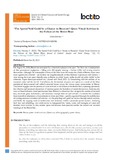| dc.contributor.author | Skinner, Chloe | |
| dc.coverage.spatial | Lebanon | en |
| dc.date.accessioned | 2023-01-12T14:55:03Z | |
| dc.date.available | 2023-01-12T14:55:03Z | |
| dc.date.issued | 2022-12-30 | |
| dc.identifier.citation | Skinner C. '‘The Spatial Void Could be a Chance to Recreate’: Queer Visual Activism in the Fallout of the Beirut Blast', Journal of Cultural Analysis and Social Change, 2022;7(2), 12, DOI: 10.20897/jcasc/12753 | en |
| dc.identifier.uri | https://opendocs.ids.ac.uk/opendocs/handle/20.500.12413/17831 | |
| dc.description.abstract | On August 4th, 2020, Beirut was torn apart by a chemical explosion at its port. The blast was a consequence of dire government negligence – killing over 200 people, injuring a further 6,500, and causing massive destruction. Although the catastrophic effects of the blast were felt across the whole of Beirut, those areas most significantly affected – particularly the neighbourhoods of Mar Mikhael, Gemmayze and Geitawi – were among the most queer-friendly areas in Beirut, in which ‘queer bodies [could be] safely visible’ in the otherwise ‘hyper-(hetero)sexualized city’ (Aouad and Abed, 2021: 3). Intersecting with the realities of an economic crisis and the Covid-19 pandemic, the devastation of queer safe spaces as a result of the blast precipitated deep material and indeed existential losses across the diverse queer communities of Beirut. This article engages with the process of visual activism in the fallout of the Beirut blast, exploring specifically the affective and temporal dimensions of creation against the backdrop of spatial destruction. Analysing the work of three Lebanese visual practitioners from Beirut, I explore how they navigate the terrains of material loss, traumatic grief, reclamation, and resistance through their art and activism. I examine the evolution from immediate adaptation to humanitarian activism post-blast – quickly organised through the mobilisation of existing networks of artists and activists – to the grappling with grief and trauma through artistic outputs, and finally the ongoing work of reclamation and recreation within a particular spatial context. Analysing both loss and rebuilding, this article serves to foreground the voices, work, and strategies of queer and feminist visual activists as they reclaim space and reassert their presence amidst the trauma and material wreckage of the Beirut blast. | en |
| dc.description.sponsorship | Sida | en |
| dc.language.iso | en | en |
| dc.publisher | Lectito Journals | en |
| dc.rights.uri | http://creativecommons.org/licenses/by/4.0/ | en |
| dc.subject | Gender | en |
| dc.subject | Politics and Power | en |
| dc.subject | Security and Conflict | en |
| dc.subject | Sexuality and Development | en |
| dc.title | ‘The Spatial Void Could be a Chance to Recreate’: Queer Visual Activism in the Fallout of the Beirut Blast | en |
| dc.type | Article | en |
| dc.rights.holder | Copyright © 2022 by Author/s and Licensed by Lectito BV, Netherlands | en |
| dc.identifier.externaluri | https://www.lectitopublishing.nl/Article/Detail/the-spatial-void-could-be-a-chance-to-recreate-queer-visual-activism-in-the-fallout-of-the-beirut-12753 | en |
| dc.identifier.doi | 10.20897/jcasc/12753 | |
| dcterms.dateAccepted | 2022-12-30 | |
| rioxxterms.funder | Default funder | en |
| rioxxterms.identifier.project | Countering Backlash | en |
| rioxxterms.version | VoR | en |
| rioxxterms.versionofrecord | 10.20897/jcasc/12753 | en |
| rioxxterms.funder.project | b885acf3-8075-4f92-9c40-49db2130c75d | en |


